I think it's safe to say we’re settling into steady routines.
Our daily pathways are gradually becoming our only pathways; whether it be
to or from class, work, home, the library or the food truck.
We’re all just moving along.
The same old. The same new.
To break with routine, I decided to visit the AGO (Art Gallery of Ontario) before midterm season arrived, and catch the
Ai WeiWei exhibit that will end October 27
th (so everybody go ASAP).
(The AGO is free Wednesday evenings 6-8:30PM, tickets for the exhibit will be half-price then.)
With half an hour to spare, I wandered around and found an exhibit (unfortunately now done its run at the AGO) featuring
Sorel Etrog, a
Romanian-born Canadian Sculptor/Philosopher.
I was quite taken with his sculptures and other works, impressed by how they mingled impressions and images with ideas and socio-political commentary.
As I left, I noticed a wall full of pictures of Etrog’s artwork displayed around the city of Toronto and the rest of Canada. What caught my attention was a familiar snap of Hart House.
It turns out the giant sculpture in front of Hart House Theatre is an Etrog piece.
How about that?
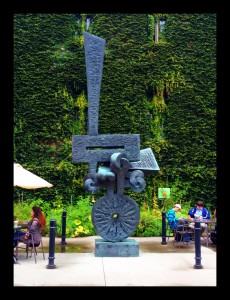 Survivors are not Heroes (1967), Sorel Etrog - Hart House Theatre
Survivors are not Heroes (1967), Sorel Etrog - Hart House Theatre
Unknowingly, I'd been walking by famous pieces of art everyday for the last four years.
This put things into perspective for me.
We usually think of campus learning as visions of classrooms, extra-curricular campus activities, public lectures or events.
But the physical campus can teach us too. Our university is rich with dialogue and ideas we can learn simply by paying closer attention to what is around us – people, spaces, architecture, and artwork.
So for an afternoon, I deviated from my usual routes.
I went to look for them.
Some stand quietly over spaces of repose, tucked quietly away from the busy traffic of campus.
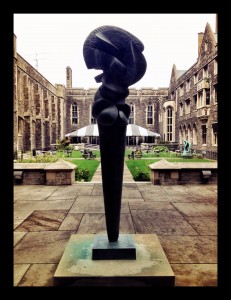 Complexes of a Young Lady (1962), Sorel Etrog - Hart House courtyard
Complexes of a Young Lady (1962), Sorel Etrog - Hart House courtyard
Some require us to change the direction of our gaze, upward instead of forward.
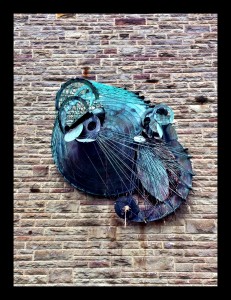 Solar Net (1963), Gerald Gladstone - Gerald Larkin Bldg
Solar Net (1963), Gerald Gladstone - Gerald Larkin Bldg
Some stand conspicuously along our path and yet we walk by them and never stop to wonder why they are there.
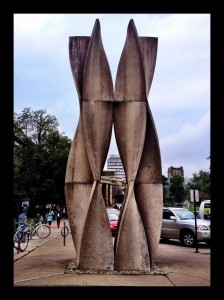 Helix of Life (1971), Ted Bieler - Medical Sciences Bldg
Helix of Life (1971), Ted Bieler - Medical Sciences Bldg
Others are unassuming at first, but unfold in beauty and complexity the more we pay attention.
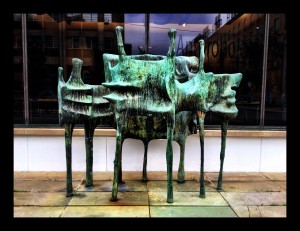
Cedars (1962), Walter Yarwood - Anthropology Bldg
Which is really what becoming educated is about: being engaged and stretched beyond our preferences or personal habits, learning to observe, interpret and critique the world around us.
If I can go out of my way to visit the AGO, I can definitely go out of my way to notice, and wonder about familiar landmarks on my daily paths.
What is it?
What does it mean?
Why is it there?
Do I like it? Why?
There are many more pieces I didn’t capture, but I found a particularly comprehensive photo collection of
Toronto sculpture.
There are also plenty of opportunities on campus to interact with art at the UofT's
Artszone.
This Saturday
(October 5th) is
Nuit Blanche, a free, all-night, citywide contemporary arts event featuring over 100 different art installations. Ai WeiWei's
Forever Bicycles installation, featuring over 3000 bicycles connected to each other is a major highlight. There will be a couple of installations on campus itself, and many more concentrated along University and Dundas.
If where we choose to walk can show us more than we expected, why not make the entire city our pathway for a night?
I think Nuit Blanche is as game for
#TryitUofT as anything.
The city is also our campus.
Take advantage of all that it has to offer.
 Survivors are not Heroes (1967), Sorel Etrog - Hart House Theatre
Survivors are not Heroes (1967), Sorel Etrog - Hart House Theatre Complexes of a Young Lady (1962), Sorel Etrog - Hart House courtyard
Complexes of a Young Lady (1962), Sorel Etrog - Hart House courtyard
 Solar Net (1963), Gerald Gladstone - Gerald Larkin Bldg
Solar Net (1963), Gerald Gladstone - Gerald Larkin Bldg Helix of Life (1971), Ted Bieler - Medical Sciences Bldg
Helix of Life (1971), Ted Bieler - Medical Sciences Bldg
0 comments on “in which the classroom is bigger than we anticipated”